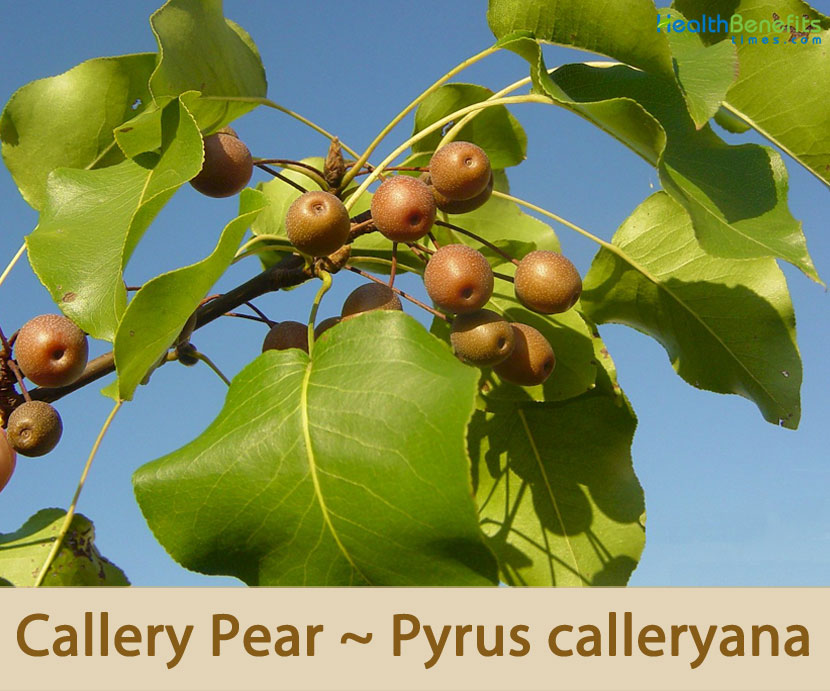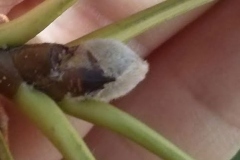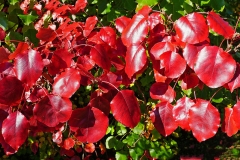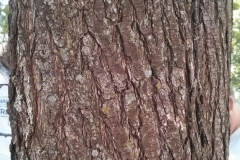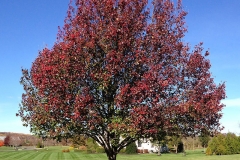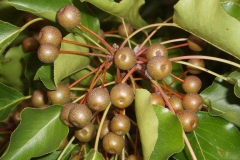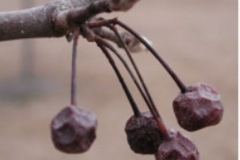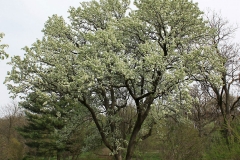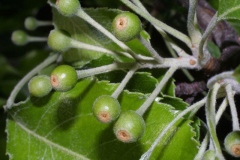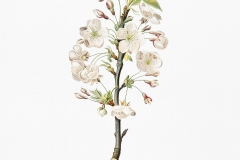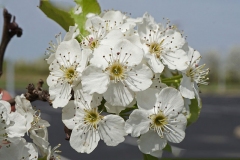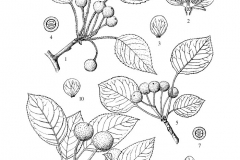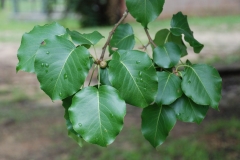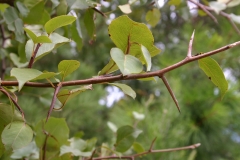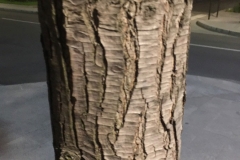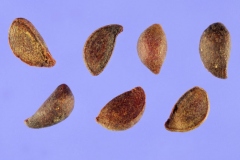| Callery Pear Quick Facts | |
|---|---|
| Name: | Callery Pear |
| Scientific Name: | Pyrus calleryana |
| Origin | China South-Central, China Southeast, Vietnam, Taiwan, Japan, China North-Central |
| Colors | Green when young turning to olive-brown to tan in color speckled with tiny russet dots as they mature |
| Shapes | Spherical to slightly oblong, 0.5 in. (1.3 cm) in diameter, brown to yellow-brown, white to tan dotted |
| Taste | Bitter |
| Name | Callery Pear |
|---|---|
| Scientific Name | Pyrus calleryana |
| Native | China South-Central, China Southeast, Vietnam, Taiwan, Japan, China North-Central |
| Common Names | Bradford pear, Callery pear |
| Name in Other Languages | Chinese: Dou li, Mamenashi (豆梨) Danish: Kina-Pære English: Bradford pear, Callery pear Finnish: Kiinanpäärynä French: Poirier de Chine Japanese: Mame-nashi (マメナシ) Polish: Grusza drobnoowocowa Portuguese: Pereira-comum-da-china Swedish: Litet kinapäron |
| Plant Growth Habit | Medium-sized ornamental deciduous tree |
| Growing Climates | Slopes, plains, mixed valley forests, thickets, stream sides, woodland edges, bottomland forests, old field fencerows, roads, rights-of-ways, along the margins of understory along creek banks, degraded open woodlands, woodland borders and fallow fields |
| Plant Size | Up to 60 ft. (18 m) in height and 2 ft. (0.6 m) in diameter |
| Bark | Bark is light brown to reddish-brown and smooth with lenticels in younger plant turning to greyish-brown with shallowly furrowed and scaly ridges with maturity |
| Twigs | Twigs are thorn less in cultivated trees, but in wild types (including trees that develop from sprouts of a tree that was felled), the twigs end in thorns. Twigs are reddish-brown to grey with large, ovate, fuzzy terminal buds about 0.5 to 1.5 centimeters in length on branch tips and spur shoots. |
| Leaf | Leaves are alternate, simple, generally oval, to 3 inches long, with rounded teeth, glossy green, turning orange, gold, red, pink, and/or purple in fall |
| Flowering season | April to May |
| Flower | Large clusters of brilliantly white, 5-petaled flowers, 1 inch (2.5 cm) across with many jutting, maroon-tipped anthers, appearing before leaves |
| Fruit Shape & Size | Spherical to slightly oblong, 0.5 in. (1.3 cm) in diameter, brown to yellow-brown, white to tan dotted, resembles a tiny pear, very bitter |
| Fruit Color | Green when young turning to olive-brown to tan in color speckled with tiny russet dots as they mature |
| Propagation | By seed and root suckers |
| Taste | Bitter |
| Season | September to October |
Plant Description
Callery pears are a medium-sized ornamental deciduous tree that normally grows about 60 ft. (18 m) in height and 2 ft. (0.6 m) in diameter. The crown shape is variable, depending on the cultivar, ranging from broadly ovate to pyramidal to columnar. The branches range from glabrous to sometimes densely pubescent. Terminal buds of the species are densely pubescent and much larger than those of other Pyrus species, often reaching 12-15 mm in length. The plant is found growing in slopes, plains, mixed valley forests, thickets, stream sides, woodland edges, bottomland forests, old field fencerows, roads, rights-of-ways, along the margins of understory along creek banks, degraded open woodlands, woodland borders and fallow fields.
Stem
Twigs initially hairy, stubby, and tipped by a sharp thorn in escaped plants, being longer branched with few thorns in cultured, planted varieties. Terminal and lateral bud scales loose, gray-hairy and elongated to 0.5 inch (1.2 cm). Twigs are thorn less in cultivated trees, but in wild types (including trees that develop from sprouts of a tree that was felled), the twigs end in thorns. Twigs are reddish-brown to grey with large, ovate, fuzzy terminal buds about 0.5 to 1.5 centimeters in length on branch tips and spur shoots. Bark is light brown to reddish-brown and smooth with lenticels in younger plant turning to greyish-brown with shallowly furrowed and scaly ridges with maturity. Stems and boles often spotted with gray and green lichens.
Leaves
Leaves are alternate, often tufted on short branchlets. They are initially circular and hairy, maturing to glossy and ovate or slightly cordate with a tapering tip, 1.5 to 3.5 inches (4 to 9 cm) long and wide, leathery with finely crenate and wavy margins sometimes having a pronounced tip. Leaves are dark green above and light green below, becoming brilliantly red, yellow, to maroon in fall. Thin petioles 1 to 2 inches (2.5 to 5 cm) long with thin stipules that shed early. Leaf margins are toothed and the base of the leaf is rounded.
In summer, the shining foliage is dark green and very smooth, and in autumn the leaves commonly turn brilliant colors, ranging from yellow and orange to more commonly red, pink, purple, and bronze. However, since the color often develops very late in autumn, the leaves may be killed by a hard frost before full color can develop.
| Leaf arrangement | Alternate |
| Leaf type | Simple |
| Leaf margin | Crenate; serrate |
| Leaf shape | Ovate |
| Leaf venation | Pinnate; reticulate |
| Leaf type and persistence | Deciduous |
| Leaf blade length | 2 to 4 inches; less than 2 inches |
| Leaf color | dark green and shiny on top, paler green underneath |
| Fall color | Orange; purple; red; yellow |
| Fall characteristic | Showy |
Flowers
The plant produces large clusters of brilliantly white, 5-petaled flowers, 1 inch (2.5 cm) across with many jutting, maroon-tipped anthers, appearing before leaves, tufted often from mid thorn, covering trees to make conspicuous invaders in early spring. Flowers normally emit an unpleasant odor and can cause allergic sinus reactions. Flowering occurs early in the spring (April to May) before the leaves emerge.
| Flower color | white or tinged with pink |
| Flower characteristics | very showy; has an aroma that some find unpleasant; emerges in clusters on 3” long cymes |
Fruit and seeds
Fertile flowers are followed by persistent clusters of small pears (pomes), 0.3 to 0.5 inch (8 to 12 mm) long and wide. The fruits are initially green ripening to tan then maroon with numerous surface speckles, dangling on thin, 1-inch (2.5 cm) long stems. They are fleshy, tart but edible, containing 2 to 6 maroon seeds and numerous stone cells. Fruits are hard, almost woody, until softened by frost, after which they are readily taken by birds, which disperse the seeds in their droppings.
| Fruit shape | Round |
| Fruit length | < .5 inch |
| Fruit covering | Dry or hard |
| Fruit color | Brown; tan |
| Fruit characteristics | Attracts birds; attracts squirrels and other mammals; inconspicuous and not showy; no significant litter problem; persistent on the tree |
Few Facts about Callery Pear
- This species is widely used as a rootstock, especially for cultivars of Pyrus pyrifolia.
- The wood of this species is hard and close-grained, and is sometimes used for making furniture and stools.
- Pear wood is also among those preferred for preparing woodcuts for printing, either end-grained for small works or side-grained for larger.
- Callery pear has been used as rootstock for grafting such pear cultivars as Comice, Bosc, or Seckel, and especially for Nashi.
- The wood is used for making woodwind instruments and furniture.
Callery Pear Management Info
Preventative measures: Swearingen et al. recommend not planting Pyrus calleryana. The root stock of grafted plants can sprout and reproduce by crossing with the upper scion. Sucker growth should be promptly removed to prevent possible cross pollination with the scion.
Physical
Pull up seedlings by hand or with a gardening tool which helps capture the roots. Cut down trees and immediately treat entire surface area of cut stump with a systemic herbicide such as concentrated glyphosate or triclopyr, following all labeling instructions, to prevent resprouting. Adult trees can be girdled in spring or summer by cutting through the bark around the entire circumference of the tree at the base of the tree. Mowing is not effective because of likelihood of resprouting.
Chemical
Treat entire surface area of any cut stumps immediately with a systemic herbicide such as concentrated glyphosate or triclopyr, following all labeling instructions, to prevent resprouting. To prevent fruiting of adult trees, spray with ethephon during full bloom; only 95% effective.
References:
https://www.itis.gov/servlet/SingleRpt/SingleRpt?search_topic=TSN&search_value=504706#null
http://www.hear.org/pier/species/pyrus_calleryana.htm
https://npgsweb.ars-grin.gov/gringlobal/taxon/taxonomydetail?id=30463
https://pfaf.org/user/Plant.aspx?LatinName=Pyrus+calleryana
http://www.missouribotanicalgarden.org/PlantFinder/PlantFinderDetails.aspx?kempercode=c136
https://plants.usda.gov/core/profile?symbol=pyca80
https://www.invasive.org/browse/subinfo.cfm?sub=10957
https://www.cabi.org/isc/datasheet/46188
https://www.cal-ipc.org/plants/profile/pyrus-calleryana-profile/
http://www.efloras.org/florataxon.aspx?flora_id=1&taxon_id=200011181
https://texasinvasives.org/plant_database/detail.php?symbol=PYCA80
http://www.iucngisd.org/gisd/species.php?sc=1389
http://www.theplantlist.org/tpl1.1/record/rjp-6009
https://en.wikipedia.org/wiki/Pyrus_calleryana
https://gd.eppo.int/taxon/PYUCA
http://hort.ufl.edu/database/documents/pdf/tree_fact_sheets/pyrcalb.pdf
https://www.illinoiswildflowers.info/trees/plants/callery_pear.htm


